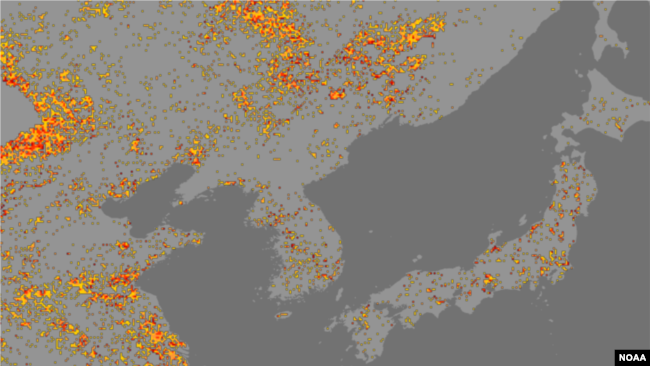북한 가뭄 해갈 위성에 포착…“봄 가뭄, 이미 식량난 초래”
Satellites Captured to End Drought in N.K."Spring drought already causes food shortages"
페이지 정보
작성자 함지하 작성일 22-06-22 03:35 댓글 0본문

이달 6~12일 주간 상황을 보여주는 미 해양대기청 가뭄 지수 위성 자료. 북한의 가뭄이 대부분 해갈된 사실을 알 수 있다. 자료=NOAA
Satellite data of the U.S. Oceanic and Atmospheric Administration's drought index showing the weekly situation from the 6th to the 12th of this month. It can be seen that most of the drought in North Korea has been exhausted. Data = NOAA
심각했던 북한의 가뭄이 해갈된 것으로 나타났습니다. 다만 봄 모내기 철 찾아온 가뭄으로 벌써부터 식량난 전망이 나옵니다. 함지하 기자가 보도합니다.
It turned out that the severe drought in North Korea was over. However, there is already a prospect of food shortages due to the drought that came during the spring rice planting season. Reporter Ham Ji-ha reports.
미 해양대기청(NOAA)의 가뭄 지수(Drought Index)는 북한의 가뭄 상황이 크게 개선된 모습을 보여줍니다.
The NOAA's Drought Index shows a significant improvement in North Korea's drought conditions.
VOA가 최근 공개된 미 해양대기청의 이달 6~12일 주간 위성 자료를 살펴본 결과, 가뭄을 표시하는 노란색 점은 북한 황해도와 함경도 일부 지역에서만 확인될 뿐 심각한 가뭄을 보여주는 ‘검붉은색’은 사라졌습니다.
According to the recent weekly satellite data released by the U.S. Oceanic and Atmospheric Administration from the 6th to the 12th of this month, yellow dots indicating drought are found only in some areas of Hwanghae-do and Hamgyeong-do, North Korea, but "dark red" has disappeared.
해양대기청의 가뭄 지수는 가뭄의 정도에 따라 ‘중간’과 ‘높음’, ‘심각’ 수준을 각각 노란색, 붉은색, 검붉은색으로 구분하는데, 색깔이 진할수록 가뭄이 심각하다는 의미입니다.
The Drought Index of the Korea Oceanic and Atmospheric Administration divides the levels of "medium", "high", and "severe" into yellow, red, and dark red, respectively, depending on the degree of drought.
앞서 VOA는 올해 4월 이후 가뭄 지수 자료를 분석해 중부지역인 황해북도와 황해남도 일대에서 시작된 검붉은색이 5월 이후 함경도를 비롯한 북한 전역으로 번졌다고 보도한 바 있습니다.
VOA previously analyzed drought index data since April this year and reported that dark red, which began in the central regions of North Hwanghae and South Hwanghae, has spread to Hamgyeong-do and other North Korea since May.
하지만 6월 초부터 북한 전역에 비가 내리면서 전지역에 걸쳐 가뭄이 해갈된 것으로 보입니다.
However, it seems that the drought has ended throughout the region due to rain across North Korea since early June.
실제로 북한은 이달 들어 10mm 이상의 강수량을 보인 날이 많았습니다.
In fact, North Korea has seen more than 10mm of precipitation this month.
22일도 평안북도와 함경북부 지역에 10~30mm의 비가 예보돼 있으며, 23일엔 전지역에 20~80mm에 달하는 비가 내릴 것으로 예상됩니다.
On the 22nd, 10-30mm of rain is forecast in North Pyongan Province and northern Hamgyeong Province, and 20-80mm of rain is expected in all regions on the 23rd.
하지만 전문가들은 북한의 가뭄이 모내기는 물론 밀과 보리 수확에 중요한 4~5월에 찾아온 사실에 주목하며 올해도 식량난이 악화할 것이라는 전망을 내놨습니다.
However, experts have predicted that the food shortage will worsen this year, noting that the drought in North Korea came in April-May, which is important for planting as well as harvesting wheat and barley.
북한 농업전문가인 권태진 GS&J 인스티튜트 북한 동북아 연구원장은 최근 VOA에 “6월 초순경에는 모내기가 끝나야 할 상황이지만 비가 많이 오지 않으면서 모내기가 상당히 늦어졌다”고 말했습니다.
Kwon Tae-jin, director of GS&J Institute of Northeast Asia, a North Korean agricultural expert, recently told VOA, "The rice planting should be over in early June, but the rice planting has been delayed considerably due to not much rain."
또 가뭄으로 인해 이달 말 수확하는 감자나 보리, 밀 이모작의 충분한 수확량을 기대하기 어려워 보인다며 올해 농사는 출발부터 여건이 좋지 않은 상황이라고 지적했습니다.
It also pointed out that this year's farming conditions are not good from the start, saying that it seems difficult to expect a sufficient yield of potatoes, barley and wheat harvested at the end of this month due to the drought.
따라서 6월부터 다시 비가 내리고 있지만 올해 봄 강수량이 예년에 크게 미치지 못하면서 북한 농업에 타격을 줄 것으로 보입니다.
Therefore, it has been raining again since June, but this spring's precipitation is expected to hurt North Korean agriculture as it falls far short of previous years.
북한 경제 전문가인 윌리엄 브라운 미 메릴랜드 대 교수는 21일 VOA와의 전화통화에서 북한이 매년 이어지고 있는 가뭄 후유증을 극복하는 것이 시급하다고 말했습니다.
William Brown, a professor at the University of Maryland, said in a telephone interview with VOA on the 21st that it is urgent for North Korea to overcome the aftermath of the annual drought.
특히 북한은 가뭄이 끝나면 홍수로 인한 새로운 문제에 봉착하는 악순환이 이어진다며 관개와 배수 체계에 근본적인 개선이 이뤄져야 한다고 조언했습니다.
In particular, North Korea advised that fundamental improvements should be made to the irrigation and drainage system, saying that after the drought, there will be a vicious cycle of encountering new problems caused by floods.
[녹취: 브라운 교수] “In Korea you have a dry season most of the year and then you have this huge rainy season begins right about now, maybe last week, and they get a huge proportion of the rain comes in late June and July. And then after that a typhoon season too more rain. So, the rain all comes right in the middle of the summer, which can be good for crops like rice which needs a lot of rain. But you have to control the drought period before then.”
[Recording: Professor Brown] "한국에서는 일년 중 대부분 건기가 있고 바로 지금, 어쩌면 지난 주에 엄청난 양의 장마가 시작되고, 6월 말과 7월에 큰 비가 옵니다. 그리고 그 후에 태풍이 너무 많은 비를 내립니다. 그래서, 비는 한 여름에 바로 오는데, 이것은 많은 비가 필요한 쌀과 같은 농작물에 좋을 수 있습니다. 하지만 그 전에 가뭄 기간을 조절해야 합니다."
브라운 교수는 “한반도는 연중 상당 기간 건조한 날씨가 이어지다가 6월 말과 7월 많은 양의 비가 내리고, 태풍까지 찾아오면서 많은 강수량을 기록한다”면서 “여름 중반까지 내리는 비는 많은 물을 필요로 하는 벼 농사에 이롭지만, 그 전에 찾아오는 가뭄을 통제할 수 있어야 한다”고 말했습니다.
Professor Brown said, "The Korean Peninsula records a lot of precipitation as dry weather continues for a considerable period of the year, followed by heavy rain at the end of June and July, and typhoons."
이어 저수지 건설 등 국가 차원의 노력을 통해 이 문제를 해결해야 한다며, 하루 아침에 일어난 일이 아니지만 북한은 여기에 실패했다고 지적했습니다.
He then pointed out that the problem should be solved through state-level efforts such as the construction of reservoirs, and that North Korea failed to do so, although it did not happen overnight.
VOA 뉴스 함지하입니다.
I'm Ham Jiha from VOA News.
출처 : VOA한국
댓글목록 0
등록된 댓글이 없습니다.

















